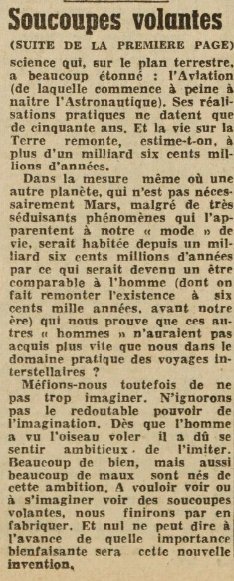The article below was published in the daily newspaper Combat, Paris, France, pages 1 and 8, on September 25, 1954.

|
The flying saucer file is growing. Each coming month will likely bring new elements in the observation of phenomena that, until now, have been almost exclusively visual—phenomena that have stirred both space and the minds of crowds for several years.
Some claim that these phenomena are not specific to our time and trace their origins... back to the Middle Ages. Let us content ourselves with the rather abundant observations of our contemporaries.
They are numerous, and while official investigation commissions have been formed in North America and England to study them as a whole, nothing in France has yet officially acknowledged the activity—so far peaceful—of these “unknown aerial craft.”
Since the maneuvering of these craft can only be explained to earthly minds by the presence of a qualified “crew” (the idea of remotely piloted craft has not yet firmly taken root in public consciousness as entities capable of moving without onboard personnel), and since the powers capable of producing such prototypes have explicitly or implicitly denied their secret existence, a connection was quickly made between these mysterious craft and potential inhabitants of the planet Mars, who would be piloting them.
Of the eight major planets orbiting the sun (the moon is merely a satellite of Earth), we obviously know that Earth is inhabited and suppose that Mars might be. The current hypotheses on the matter depict Mars as a kind of second Earth, with a similar rotation, two polar ice caps, and its own days, nights, and seasons. All these hypotheses are based on a long series of fairly convincing observations, but they will only become law once we are able to closely observe the flora (or whatever passes for it), fauna, or any other living element resembling us, on a planet that will approach us considerably in 1956.
Proving that no human life exists on the planet Mars would not resolve the question of whether the universe harbors other creatures comparable to humans. The distance between the Earth and the Sun is staggering (about 150 million kilometers), yet it is almost nothing compared to the vast stretches we attempt to measure in an Universe that, in a sense, does not “exist”—since we cannot conceive of its limits. And this Universe likely contains more solar systems than the number of stars visible to us on a clear August night.
Two astronomers from the University of Cambridge—Fred Hoyle and Raymond Arthur Lyttleton, authors of several revolutionary astronomical works—assert that within our Milky Way galaxy alone, there are at least one hundred thousand solar systems, each likely to contain at least one planet where atmospheric conditions would be favorable to life. And the Universe contains millions of star nebulae similar to the Milky Way. [*]
The day may come when inhabitants—not so much from our neighboring planet Mars but from others fabulously distant—will be able to visit us. Since we are fully engaged in futuristic speculation (even the most serious astronomers are not exempt), there is nothing to suggest otherwise. Does Earth have a monopoly on technological inventions?
Let us, for a moment, recall the extreme youth of a
Daniel DREUIL
(CONTINUED ON PAGE 8, COLUMN 2)
[*] Figures from the time, vastly underestimated. There are between 150 and 400 billion stars in our own galaxy, the Milky Way—almost all with at least one planet, most with multiple planets, among which several tens of billions are believed to be in the habitable zone; and at least 2 trillion galaxies in the observable part of the Universe.]

|
(CONTINUED FROM THE FRONT PAGE)
Science which, on the earthly level, has caused great astonishment: Aviation (from which Astronautics is only just beginning to be born). Its practical achievements date back only 50 years. And life on Earth is estimated to have begun more than 1.6 billion years ago. [*]
To the extent that another planet—which is not necessarily Mars, despite very intriguing phenomena linking it to our own "mode" of life—may have been inhabited for 1.6 billion years by what would have become a being comparable to man (whose existence is traced back to 600,000 years before our era), what proves to us that these other "men" would not have advanced more quickly than us in the practical field of interstellar travel? [**]
Let us beware, however, of imagining too much. Let us not ignore the formidable power of the imagination. As soon as man saw the bird fly, he must have felt ambitious to imitate it. Much good, but also much harm, has come from that ambition. By wanting to see—or imagining we see—flying saucers, we may end up manufacturing them. And no one can say in advance what beneficial significance this new invention might hold.
[*] The Earth is about 4.54 billion years old. Life on Earth began with certainty 3.5 billion years ago, and possibly much earlier.
[**] While the Sun is about 4.57 billion years old, the Universe is 13.8 billion years old; the first potentially habitable planets (with carbon, oxygen, silicon, etc.) appeared 10 to 12 billion years ago—three times the age of the Earth.